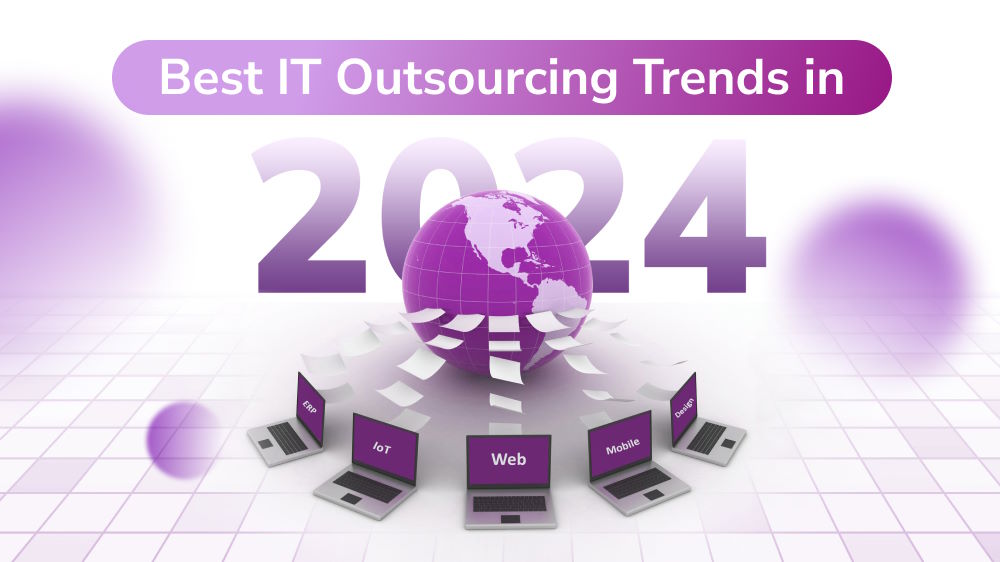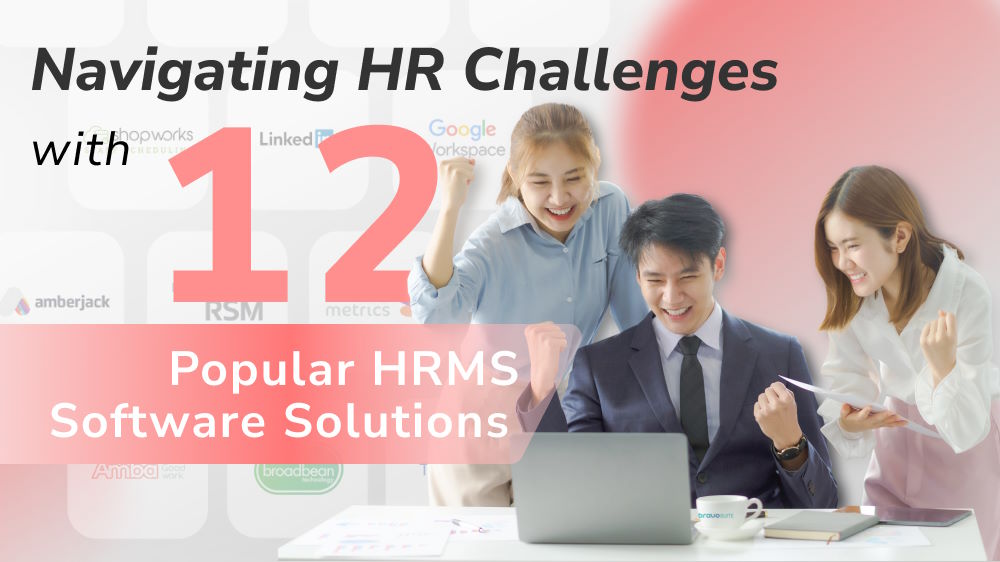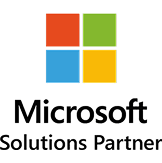
How to Form a Successful Collaboration with Your Software Development Partner
Uncover the crucial steps that guide you toward a successful software development partnership that lasts.

Content Map
More chaptersIt’s no secret that outsourcing software development can open up a shortcut toward the project’s success. Whether you are dealing with talent shortage, local hiring challenges, budget constraints, or a lack of specialized expertise and domain experience, outsourcing is a smart workaround. Through software development services and vendors, you can tap into fully dedicated teams capable of accelerating development and uplifting your project with technical precision, speed, and focus. These teams come ready with what you need to bridge the gap and deliver results without stretching your budget or internal workforce.
The benefits of outsourcing are many, but you can only unlock significant advantages with a reliable software development partner by your side. According to a 2022 survey by Deloitte, 78% of companies place a premium on a good relationship with the software partner. If a partnership lacks compatibility, the consequences might be delays, budget overruns, or disappointing outcomes. On the contrary, a well-matched outsourcing collaboration can accelerate the development process and elevate the entire project to new heights.
The importance of a good development partner cannot be overstated. However, the journey to a fruitful partnership does not happen by chance. As we said, it is a journey in which you search for potential software development partners and evaluate them one by one before identifying the right one. Still, the partnership needs more effort. In this article, we’ll show you how to invest correctly from the very start to not only find or choose a software development firm for your project requirements but also build and maintain a collaborative partnership that thrives.
Key Takeaways:
Be mindful of what truly matters when building and maintaining a collaborative partnership with a software development service vendor:
- Communication
- Trust and credibility
- Vision, goals, and expectations
- Mutual benefits
- Flexibility and accessibility
Best practices to forge a successful partnership:
- Determine requirements and expectations
- Find the right partner
- Set up an open line of communication and build mutual trust
- Set up documentation protocols
- Monitor progress and optimize collaboration as you go.
What Makes a Strong Partnership with a Software Development Company
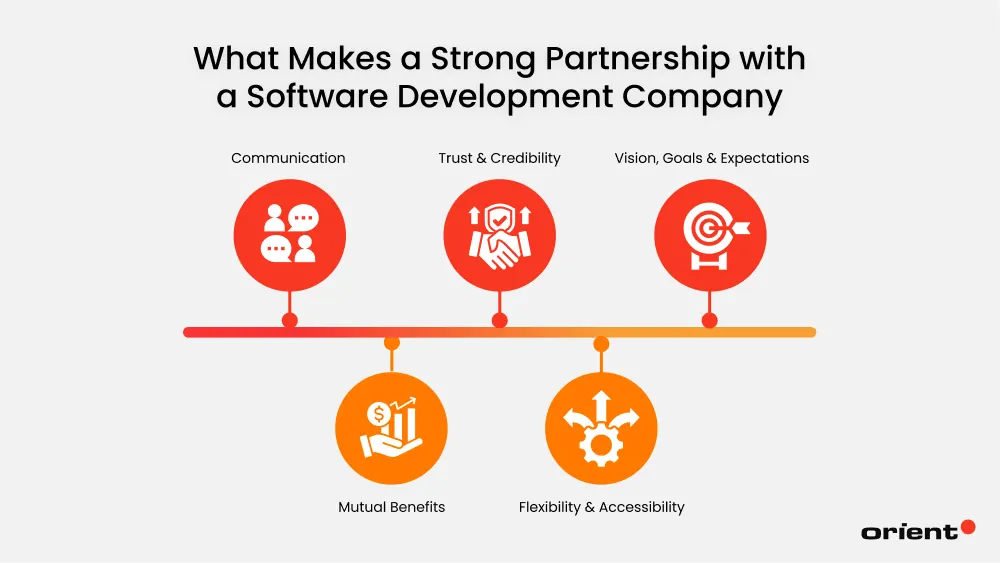
If you would like to build and sustain a “healthy” partnership with a software development company, you will need more than solely finding and signing the contract with the so-called “best vendor.” Instead, you need a strategy. Start with understanding the core principles of a strong, compatible partnership. Whether you’re working with one single provider or juggling multiple vendors at a time, the key factors that truly drive long-term success in software development collaborations remain the same. Let’s explore them now.
Communication
Clear, consistent communication is the foundation of every effective software development partnership, and transparency is its top essential component. Poor communication may derail progress, reveal inefficiencies, and, in the worst-case scenario, lead to project failure. In remote collaboration, it is often better to overcommunicate than risk ambiguity.
Project managers and stakeholders on both sides - service provider and its client - should foster a culture of open, honest dialogue. Questions should be encouraged. Feedback should be given frequently, and misunderstandings should be addressed swiftly. Hence, implementing a feedback loop early on is necessary to keep the in-house team and the outsourced one aligned, nurturing mutual trust.

Keep in mind that communication should be intentional and proactive, especially when working with a nearshore/offshore development team. Strong communication is not about simply avoiding problems. It should focus on fostering a productive environment where ideas are shared, feedback is welcomed, and continuous improvement is made a part of the culture.
- Establish a consistent routine of status updates, check-ins, and progress reviews with your partner. It is vital for a steady, uninterrupted flow of information, helping all stakeholders stay aligned on priorities, deliverables, and evolving needs.
- Integrate collaboration platforms and project management tools, such as Slack, Jira, Zoom, and Confluence, into your workflows. This streamlines information sharing, enables real-time coordination, and mitigates delays.
Trust & Credibility
In the business realm, trust is the foundation of every successful partnership. Without it, efficient collaboration becomes difficult, if not impossible. In a software development partnership, trust should be gained through consistent performance, transparency, and mutual respect over time.

The groundwork for a trustworthy relationship starts with the vendor selection process. Choosing the right partner from the outset will lay the foundation for openness, alignment, and accountability - all of which are critical to building lasting trust and confidence in your custom software development partner.
You, as a decision-maker, should center the strategy around due diligence. During this process, it is essential to assess multiple trust-building aspects that reflect one provider’s credibility. Check portfolio, case studies, and testimonials from one’s past clients.
Vision, Goals & Expectations
A lasting, productive partnership is anchored in three interconnected pillars: A shared vision, aligned business goals, and well-defined expectations. These are not mere formalities; they become the essential glue that binds both sides into one collaborative, result-driven relationship.

- A shared vision acts as the north star of an effective collaboration. It ensures both parties - you and your software development partner - stay on the same page. When an outsourcing company understands your business objectives and believes in your broader mission, not just within the technical scope of one project, they become your ally. This ensures the whole team proceeds with not only direction but also conviction and confidence.
- If the high-level vision sets the compass, goals define the measurable progress and checkpoints. Your partner interprets your vision, explains technical concepts, and translates them into actionable development plans. Beyond a technical enabler or executor, the trusted software development company you choose will be a strategic collaborator who helps refine what’s feasible, prioritize what matters most, and adapt to changing requirements in such an agile environment.
- Whether it is for service buyer or provider, expectations must be specified. These are communication norms, delivery timelines, quality standards, and how success (or failure) is evaluated. You and your partner must agree on the mutual expectations early on and revisit them as the project evolves to update them. It is necessary to minimize misunderstanding and strengthen accountability of both sides.
These are qualities that no partnership can thrive without. Plus, when supported by each other, joint ambition and strategic alignment can foster deeper engagement, proactive communication, and most importantly, a strong sense of ownership over a successful project. This fuels a truly collaborative and enduring relationship.
Mutual Benefits
A successful collaboration is not merely getting the job done but also creating value for both sides. In other words, a strong outsourcing partnership must be grounded in a win-win model. That’s how your relationship will thrive in the long run. The development partnership built on fair benefits and duties is the one that lasts. Each party has to fully understand the responsibilities within a software development partnership agreement and what each party stands to gain.
When the value exchange is equitable, trust deepens. In order to achieve that, you and your partner need to define what success looks like and agree on metrics for measurement from the outset. During this process, you need to negotiate and balance expectations, deliverables, and outcomes to ensure both parties are aligned and equally committed.
Flexibility & Accessibility
Beyond proven technical expertise, a trustworthy software development partner must also be flexible and responsive. As project requirements constantly evolve or business priorities shift, the reliable partner should be ready to pivot and adapt quickly. The outsourcing company must be open to modifying plans, accommodating new features, and resolving issues without derailing progress.
Equally important is accessibility. Simply put, a dependable partner must stay engaged throughout the entire development lifecycle and project timeline. They are committed to consistent communication, transparent updates, and timely support even post-launch. This enables iterative improvements and ensures that your product stabilizes and continues to mature without delays or cost spikes.
Together, flexibility and accessibility foster mutual trust, agility, and efficient decision-making - all of which are essential to building a high-impact outsourcing partnership that lasts.
Steps to Forge a Successful Software Development Partnership
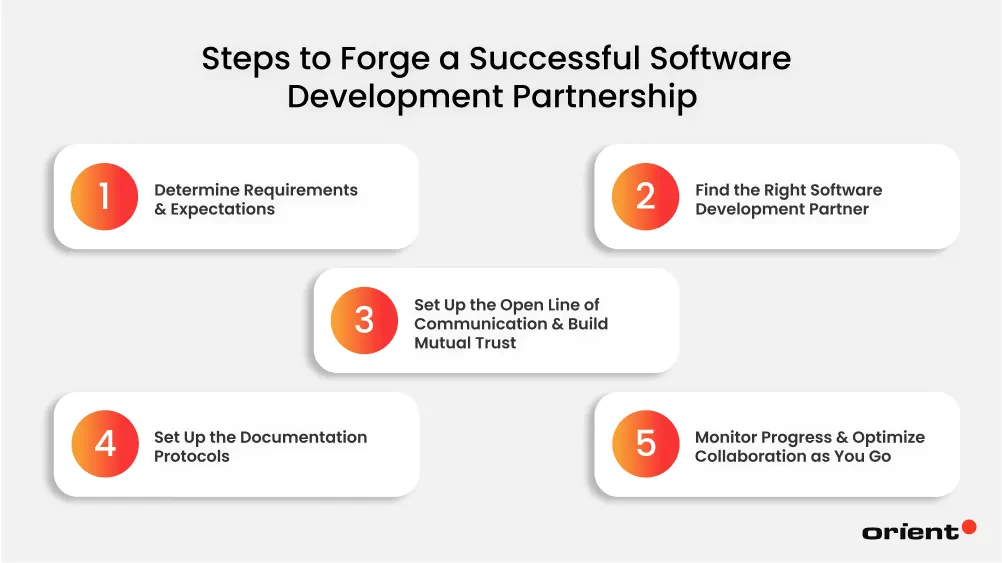
Honestly, it is uneasy to find a tech vendor that exactly fits your needs, but developing and extending a long-term partnership is doubly challenging. Luckily, it is achievable, especially after you are already well-equipped with the core values and qualities that make a successful partnership happen. What you need now is to convert your findings into a clear strategy empowered by crucial steps as below:
Firstly, Determine Requirements & Expectations
Before you search for the ideal software development partner, plan first. This step is to lay the groundwork internally before reaching out to an external company. Identify what your project requires to roll - from business goals to technical needs and resources - and outline what you expect an outsourcing partner to deliver.
The planning session includes the following areas:
Project Scope & Technical Requirements
This stage involves working closely with the technical teams to:
- Clarify what your software solution is built to do
- Define core features, functionalities, and the user outcomes you target
- Translate your business goals into technical objectives
- Decide on tech stacks and determine if you need expertise in specific domains, such as artificial intelligence, blockchain, DevOps, etc.
Workload Estimation & Resource Allocation
- Break down a project into logical phases and modules.
- Assess how much your in-house team can handle.
- Detect skill gaps and talent shortages.
- Identify not just technical skills but also required roles. E.g., UI/UX designers, QA engineers, frontend/backend developers, project managers, etc.
Goals, Milestones, and Key Performance Indicators
- Translate your needs into realistic goals and timelines for each project phase.
- Define measurable goals and milestones to keep track of progress.
- Propose and agree on the KPIs used to evaluate product quality, delivery speed, and success.
Outsourcing Destination & Model
This is the decision point where you consider your outsourcing endeavor in different aspects:
- Choose what to retain internally and what to delegate to a service provider: Engineering, design, quality assurance and testing, etc.
- Select the appropriate outsourcing model: Project-based model, dedicated development team, or staff augmentation.
- Decide where to outsource: Onshore, nearshore, or offshore. Vietnam, India, China, or other outsourcing destinations.
Budget Alignment
This is a crucial stage that might significantly influence your vendor selection.
- Determine your total budget and how flexible it is across phases.
- Decide on the suitable pricing models that fulfill your needs without breaking the bank: Fixed price, time and materials, etc.
Risk Management
- Anticipate potential outsourcing challenges: Time zone gaps, delays, cultural mismatches, or language barriers.
- Prepare buffers and coping strategies in case issues occur.
Having your project laid out into a complete plan will set the tone for your entire outsourcing journey. Preparation done well enough at this step can eliminate ambiguity and help both parties understand their roles and responsibilities in a partnership.
Secondly, Find the Right Software Development Partner
The best software development partner won’t reveal itself. Decision-makers stand in front of countless choices of service providers, and it is a daunting task to filter the “true gem” from the rest. Choosing the best fit is not about just technical capability or cost savings. The vendor selection process requires a thoughtful evaluation to conclude the one who can truly collaborate, co-create, and grow with you in the long run.
Different business owners will approach the vetting process differently. Based on their unique needs, focus, and criteria, they use their own lens to evaluate potential candidates and shortlist the most promising partners. There is no right or wrong. Therefore, we have articulated a common guide that contains the best practices for scanning and selecting the best software development partner. What else can you leverage? A few useful tips are also included. These are not any tips, but practical ones.
Just a reminder: Don’t forget to revisit the pre-requisites and stay selective. Avoid falling into the trap of cost reduction. Prioritize the right fit over the right price as your aim is a fruitful, long-term partnership. Pay attention to red flags that signal deeper misalignment.
Thirdly, Set Up the Open Line of Communication & Build Mutual Trust
As aforementioned, communication and trust are of utmost importance to a successful partnership, especially when you outsource to a remote team. That’s why clear and consistent communication must be established from day one and maintained throughout the collaboration. With that foundation, trust will grow on both sides.
A reminder at this point: When communication breaks down or trust is eroded, both sides will soon struggle with missed expectations, scope confusion, and frustration, or worse, result in failures. On the contrary, effective communication and mutual trust are cyclical, gluing a partnership over time.
You and your partner need to work closely to set up an open and reliable communication channel. It involves using project management tools and implementing routines:
- Choose and standardize tools, such as Slack, Zoom, Jira, Asana, and Confluence.
- Set a familiar cadence for meetings through daily standups, sprint demos, and weekly syncs.
- Assign points of contact on both sides. For example, project manager, product owner, tech lead, etc. Stakeholders know exactly whom to refer to when they need assistance.
- Define communication norms, including response time expectations, escalation paths, and decision approval flows.
- Encourage two-way dialogue to enable open feedback, suggestions, and sharing.
- Promote recognition and celebration to foster morale and loyalty.
A useful tip here: Overcommunicate early; and communication will evolve naturally down the road as trust is gained. Keep the three core values that help you build real connection, foster open communication, and nurture trust: Clarity, honesty, and shared responsibility.
Next, Set Up the Documentation Protocols
Communication and trust are in place; your next priority is to guarantee that knowledge flows are well-structured and transparent. That’s the documentation we are referring to.
In software development, the documentation process involves recording, organizing, and centralizing all scattered specifications about a project into one single source of truth. This is where authorized stakeholders can access reliable information from concept to deployment. Documentation should be treated as a living resource, which means frequent updates and revisions are needed as your project evolves.
Documentation plays an important role in a partnership as it preserves:
- Clarity: Ensure all stakeholders are on the same page. All are aligned with the project’s purpose, scope, requirements, and processes, leaving no room for ambiguity.
- Consistency: Record decisions to prevent information overload or fragmented communication.
- Continuity: Preserve knowledge and enable smooth handoffs when someone leaves the project.
- Scalability: Support team growth without frictions when expanding features, launching new upgrades, or onboarding new developers/switching vendors.
- Accountability: Support tracking what was agreed (commitments), delivered (outcomes), and changed.
In short, documentation is a strategic asset that empowers a strong partnership. Knowing how to manage it is the key to collaboration success across time zones, sprint cycles, and changing priorities.
Consider these tips that can ease your documentation process:
- Identify the types of documentation needed for your project. E.g., business requirements, technical specs, architecture, QA processes, and release notes.
- Assign clear ownership - outline the specific roles of each member in the procedure. For example, a project/product manager is responsible for business goals and feature specifications, while a tech lead manages architecture, APIs, and code documentation.
- Select the right tools that both in-house and outsourced teams can access. Centralized and version-controlled platforms, such as Notion, Confluence, Google Docs, or GitHub Wikis.
- Set rules for updating and reviewing documents: When will it be created, reviewed, and updated. E.g., every 4 - 6 weeks or at the end of each sprint.
- Organize documents and use version numbers, timestamps, and structured categories for traceability and easy navigation.
- Ensure secure access for all relevant stakeholders (internal and external).
- Avoid over-documenting or redundant details. Instead, keep it lean and purpose-driven.
- Make documentation a habit by embedding it into the workflow. Reference it during sprint planning, reviews, and retrospectives.
- Encourage team-wide participation. All team members should contribute and keep documentation accurate and up-to-date.
Finally, Monitor Progress & Optimize Collaboration as You Go
If you have ticked all the boxes mentioned above, congratulations. You have successfully started an outsourcing partnership and set a solid foundation for long-term collaboration. It is an important milestone; still, just the beginning. Settling down with the right partner is a good start. However, a long-term, collaborative relationship is far from finished; you’ll need to invest more effort to sustain and strengthen it over time. And it is an ongoing mission. At this point, measuring success is more about the health of your collaboration.
Here’s your to-do list:
- Stay Involved and Monitor Progress Consistently: Especially when development is underway or after launch, you should track your partner’s performance for continuous alignment. The ultimate goal is to check what’s working well and what needs adjustment. Make space for:
- Regular check-ins to review the project’s “health” and detect any blockers.
- Ongoing backlog grooming will reflect the latest priorities.
- Active collaboration on sharing feedback and refinements.
- Fine-tune How You Work Together: A valuable partnership will adapt naturally. As your project evolves and priorities shift, your workflow cannot stay static. You’ll need to review current processes and welcome refreshment.
- Think Beyond the Project: Treat your outsourcing engagement as a part of your growth. If your collaboration is strong, consider expanding it in more future projects. Long-term thinking enables you to unlock the true potential of a vendor and empower innovation, turning a service provider into an enduring collaborator.
Orient Software as Your Right Software Development Outsourcing Partner
Applause for those who’ve made it this far. What a journey it has been. And your efforts paid off. From laying the groundwork and choosing the right software development partner to building trust and evolving the relationship, you have gained a roadmap for an outsourcing partnership that truly lasts. Now is the time to. Start looking for your outsourcing partner.
Look no further! You got Orient Software.
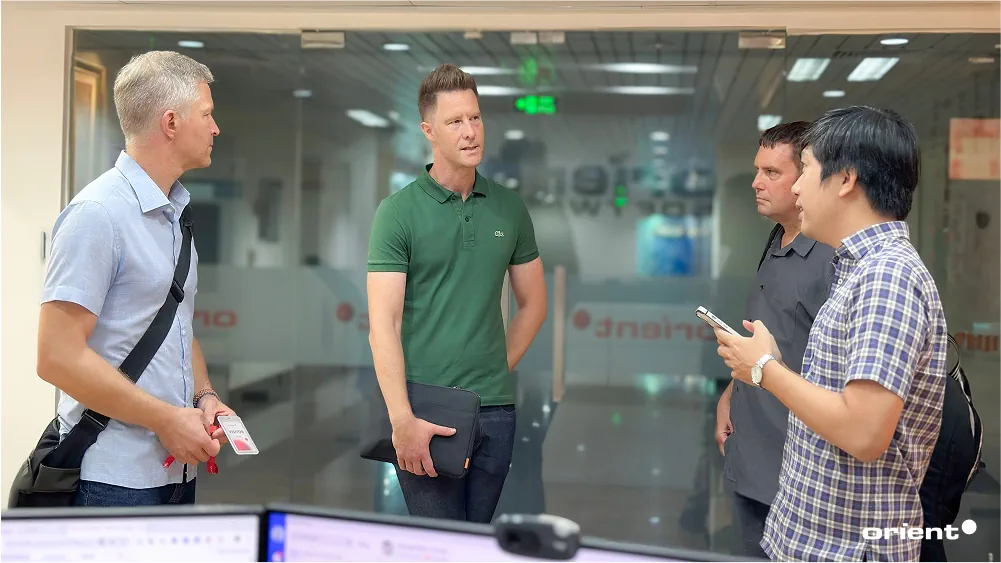
Orient Software is a top-tier software development outsourcing company headquartered in Vietnam, one of the world’s IT powerhouses. Whether you want to build a new product, modernize legacy systems, or scale your tech team, we are your one-stop solution provider. Our service offerings include custom software development (web apps, mobile apps, AI solutions, and more), staff augmentation, UI/UX design, QA testing, and more. Our company’s reputation has been built on over 20 years of experience in the IT outsourcing industry. We are the strategic partner of over 100 clients from all around the world and across industries.
Let’s discuss your project in a real conversation, face-to-face or screen-to-screen. Send us a request for free consultation - no commitment yet, just clarity. We are excited to help you bring your vision to life. It could be the start of a partnership that lasts a lifetime.




